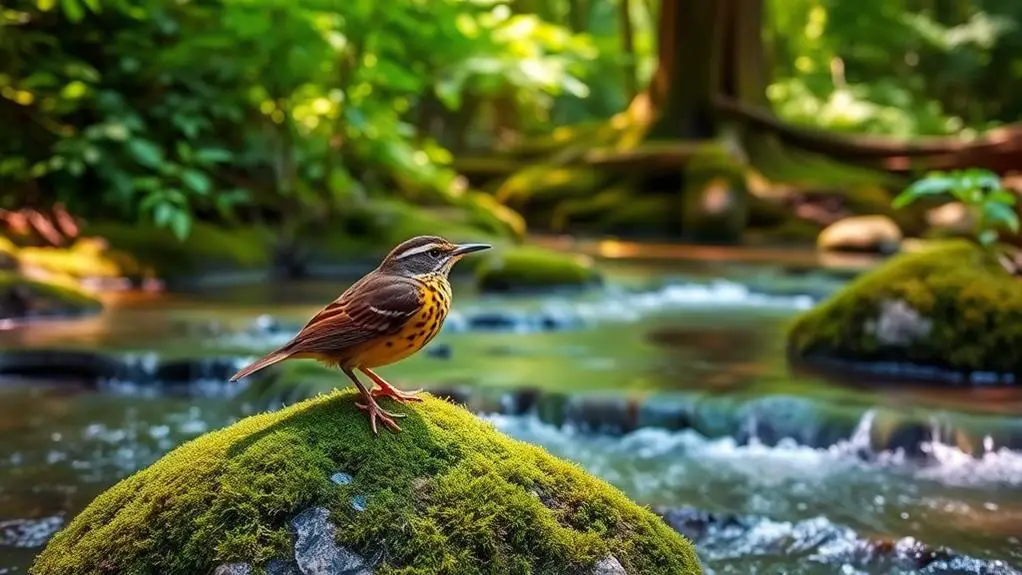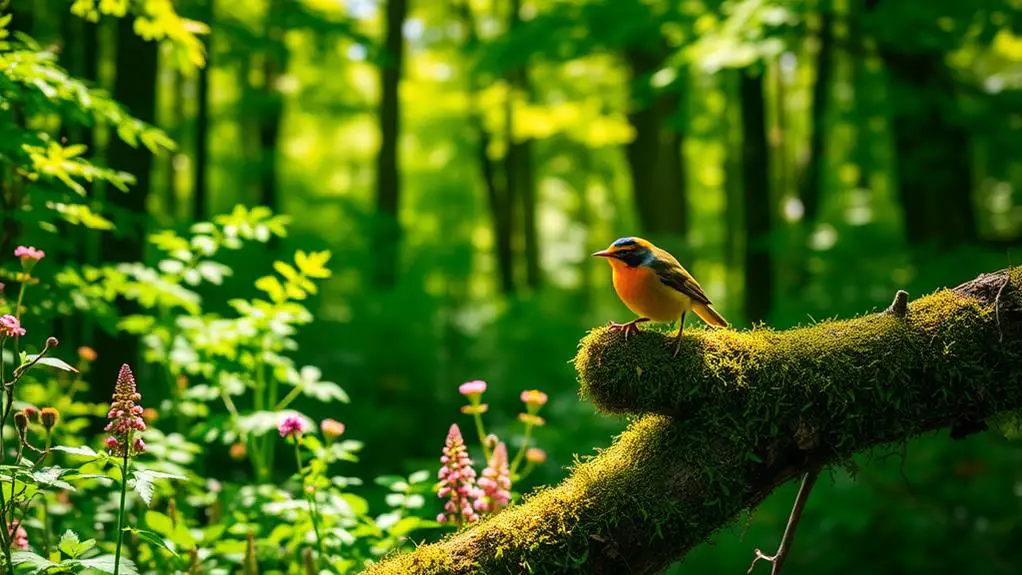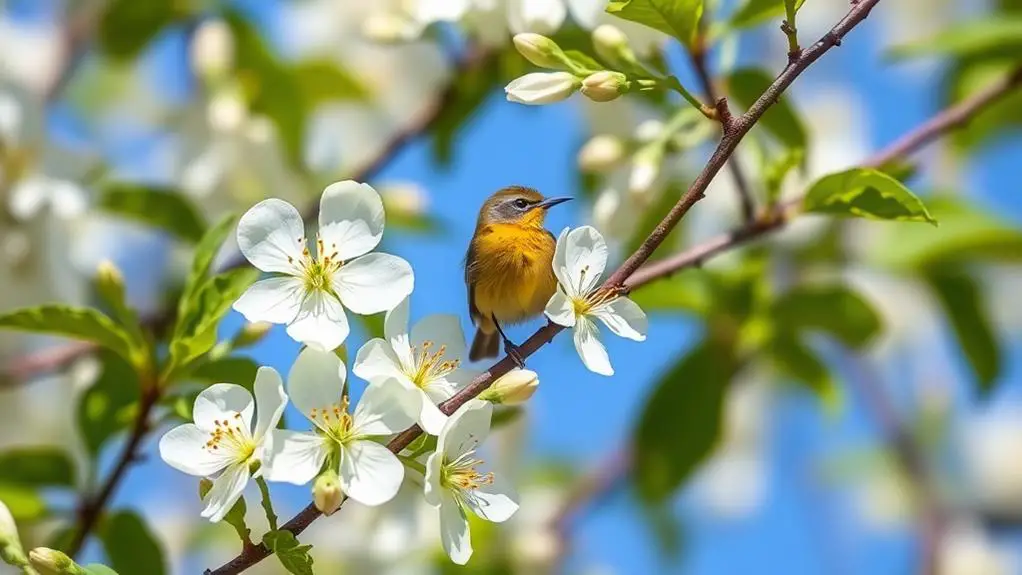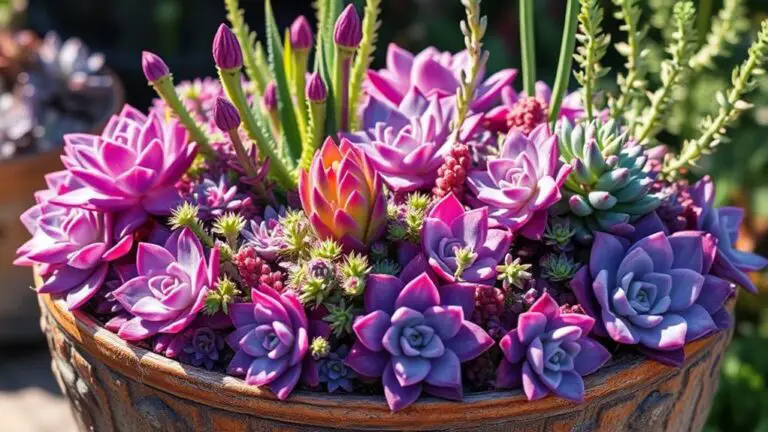Top 5 Birds Named After U.S. States
When you think about birds named after U.S. states, you might picture the impressive California Condor or the vibrant Kentucky Warbler. These birds don't just carry state names; they embody unique stories of survival, adaptation, and ecological significance. Whether it's the Tennessee Warbler contributing to ecosystem health or the Louisiana Waterthrush indicating pristine water quality, these avian species highlight the diverse habitats across the country. And let's not forget the Alaska Willow Ptarmigan's incredible seasonal plumage changes. Curious about how each bird represents its state? There's more to uncover about their fascinating traits and the roles they play.
Louisiana Waterthrush

When you see a Louisiana Waterthrush, you're likely near a healthy freshwater ecosystem. These birds are important indicator species, meaning their presence signals good water quality.
They breed in the northern U.S. and Canada during the summer months, raising their young in the cool, shaded wetland areas. In the winter, they migrate south to Central America.
Their diet mainly consists of insects and small invertebrates, which they skillfully capture along stream banks. Watching them forage is fascinating; they seem to dance as they search for food.
If you're trying to spot one, look near clean, flowing streams with plenty of vegetation.
Understanding the Louisiana Waterthrush helps you appreciate the interconnectedness of our ecosystems. Protecting wetland areas guarantees these birds continue thriving, highlighting the importance of conserving freshwater habitats for future generations.
California Condor

Although once on the brink of extinction, the California Condor has made a stunning comeback thanks to concerted conservation efforts. This magnificent bird, the largest in North America, boasts a wingspan of up to 9.5 feet. It's truly a sight to behold when you see it soaring across vast landscapes.
You'll find the California Condor in the mountainous regions and coastal areas of California, Arizona, and Utah. These open spaces are perfect for their foraging and nesting needs.
As scavengers, California Condors feed mainly on carrion, which means they play a vital role in their ecosystem. By cleaning up dead animal remains, they help keep the environment healthy.
One of the most striking features of the California Condor is its appearance. It has a black body with distinctive white patches on its wings. Its bare head, which helps with thermoregulation and hygiene, adds to its unique look.
Because of dedicated conservation efforts, the population of these incredible birds has grown to over 500 individuals.
Alaska Willow Ptarmigan

From the soaring heights of the California Condor, let's turn our attention to the Alaska Willow Ptarmigan, another fascinating bird named after a U.S. state. The Alaska Willow Ptarmigan is the official state bird of Alaska, known for its incredible adaptability to cold climates.
One of its most fascinating traits is its ability to change its plumage with the seasons. In summer, it sports a brown coat to blend in with the tundra, while in winter, it turns white to camouflage against the snow.
These ground-dwelling birds primarily inhabit tundra and shrubland ecosystems where they forage for leaves, buds, and berries. You might hear their distinctive calls, a series of sharp clucks, especially during the breeding season. This call not only attracts mates but also plays a role in establishing territory.
The Alaska Willow Ptarmigan is an essential part of its ecosystem. It serves as a prey species for various predators, including foxes and birds of prey. Its feathered feet are another unique adaptation, providing warmth as it navigates the chilly terrain.
Understanding the Alaska Willow Ptarmigan helps appreciate the intricate balance of nature in Alaska's rugged landscapes.
Kentucky Warbler

The Kentucky Warbler, a small songbird with a striking appearance, captivates bird enthusiasts with its bright yellow chest and olive-green back. You'll often find this bird in the dense underbrush and wet woodlands of the southeastern U.S., especially near streams and shaded areas. It's a migratory species, traveling to Central America during the winter and returning to the U.S. in the spring to breed.
The Kentucky Warbler's loud and distinctive song, made up of sharp "chip" notes, is often heard from low perches. This song is a key identifier when you're out birdwatching. The bird's nesting habits are also fascinating, as it builds its nest close to the ground in thick foliage, providing safety for its young.
In 1942, the Kentucky Warbler was designated the state bird of Kentucky, a symbol of the region's rich avian diversity. This little bird symbolizes the natural beauty and variety of wildlife in the state.
Here's a quick look at some key facts about the Kentucky Warbler:
| Fact | Detail |
|---|---|
| Appearance | Bright yellow chest, olive-green back |
| Preferred Habitat | Dense underbrush, wet woodlands |
| Migration | Winters in Central America |
| Distinctive Song | Sharp "chip" notes |
| State Bird of Kentucky | Designated in 1942 |
Understanding the Kentucky Warbler helps you appreciate the unique avian diversity in Kentucky. Happy birdwatching!
Tennessee Warbler

You can't miss the Tennessee Warbler, a small songbird with a gray-green body and bright yellow underparts that make it stand out among warblers. This visually distinctive bird is known for its loud and varied song. When you hear its clear, whistled notes, you'll know it's nearby, even if you can't see it right away.
The Tennessee Warbler isn't just a pretty face; it plays an important role in the environment. During its migration, which passes through Tennessee in the spring and fall, it helps control insect populations by feeding primarily on insects and berries. This makes it a valuable part of the region's avifauna.
- Migrates through Tennessee: You'll spot it most during spring and fall.
- Breeding range: Extends into Canada and the northern United States.
- Designated state bird: Recognized officially in 1987.
The Tennessee Warbler's breeding range is quite extensive, reaching into Canada and the northern United States. Its importance was highlighted when it was designated as the state bird of Tennessee in 1987.
This little bird might be small, but its presence and song make a big impact on the environment and those who observe it.
Frequently Asked Questions
Do All 50 States Have a State Bird?
Yes, all 50 states have designated an official state bird. These birds reflect each state's unique wildlife and cultural identity. Many were chosen through public campaigns or contests, representing regional significance and public sentiment.
What Are the Top 20 Bird Names?
You're looking for the top 20 bird names, and it's fascinating to see which ones make the list. Focus on popular birds like the Bald Eagle, Cardinal, and Blue Jay. Check ornithology resources for an extensive list.
How Many Unique State Birds Are There?
You're wondering how many unique state birds there are. Out of the 50 states, there are 50 designated state birds, but only 18 are unique, since 32 states share their official birds with others.
Which Bird Is Only Found in the USA?
You're looking for a bird found only in the USA? The California Quail fits that description. It's the state bird of California, known for its unique plume and social behavior, often forming coveys in chaparral and grasslands.
Conclusion
You've now learned about five incredible birds named after U.S. states. Each bird, from the California Condor to the Louisiana Waterthrush, has its unique traits and story. These birds remind us how important it is to protect their habitats. By understanding and preserving these special places, you're helping to guarantee these amazing birds thrive. Keep exploring and learning about nature; your efforts make a big difference! Happy birdwatching and gardening!







